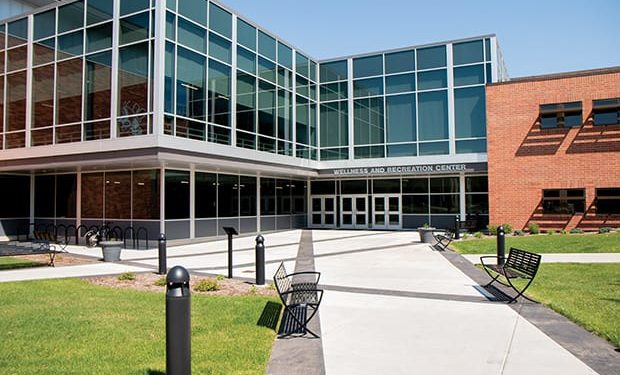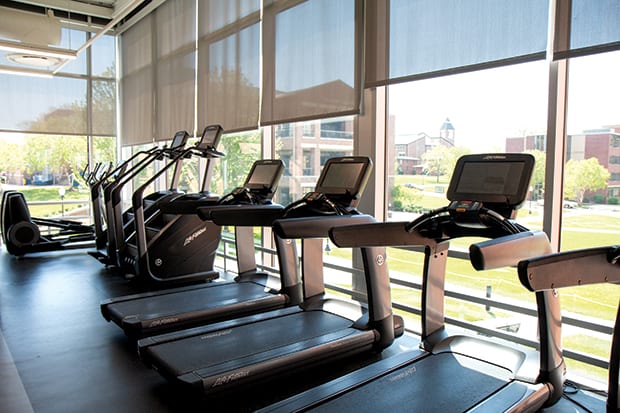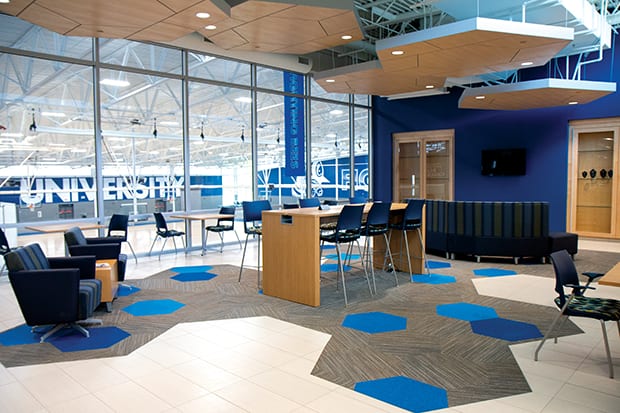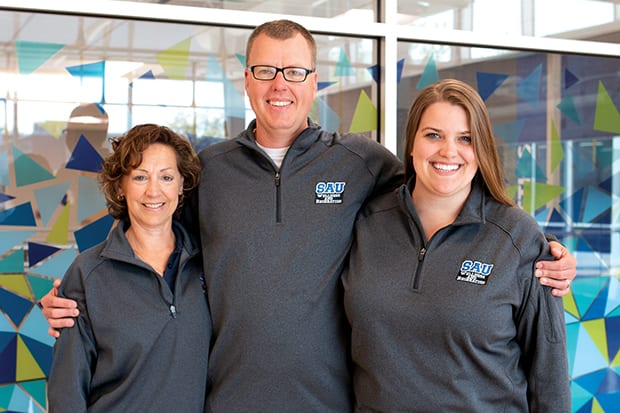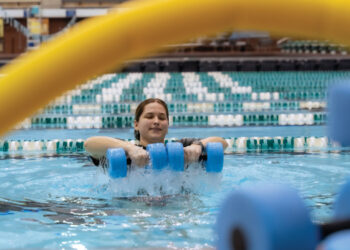Standing in the group fitness room of St. Ambrose University’s Wellness and Recreation Center (WRC), you have a stunning view of the very blue Iowa sky spanning above the entirety of campus.
The small university sits in a residential area of the city of Davenport. Founded in 1882, the private institution has an undergraduate enrollment of approximately 2,400 students. And while that group fitness room view was always there, it wasn’t always visible; at one time, the group fitness room was the upper part of a racquetball court. That is, until August of 2017 when the new rec center opened.
The $20 million project was 80,000 square feet and involved both new construction and renovation. It includes a 56,000-square-foot field house with two wood and two multi-purpose surface courts, a second floor overlook, 5,400 square feet of recreation/cardio space, two weight rooms and more.
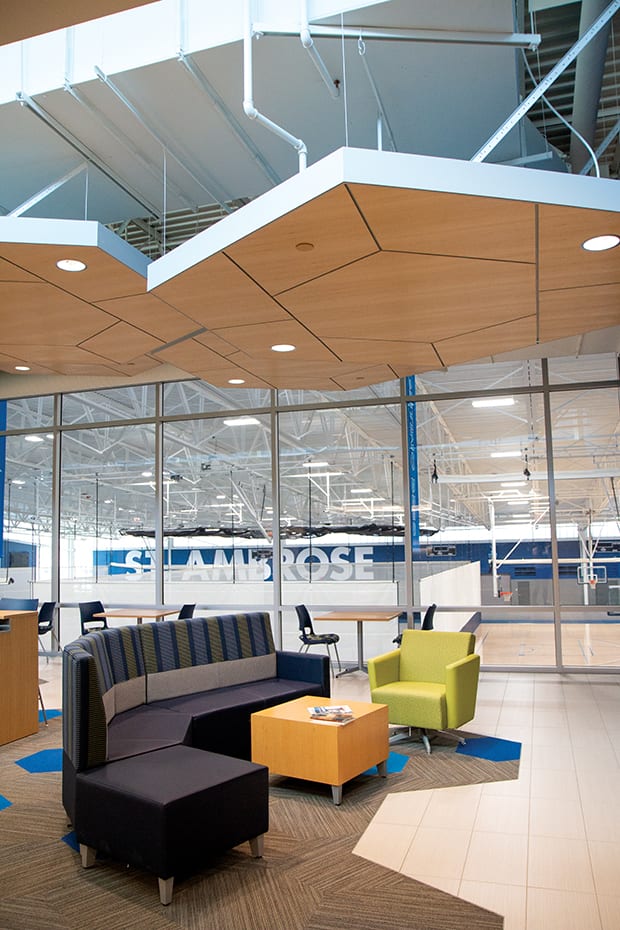
It was this fact of sharing the space that created one of the largest challenges in building the new facility, shared Andrew Milton, the director of wellness and recreation. “It’s different if the budget was all going to a collegiate recreation department versus the shared model we have,” said Milton. “That made it unique.”
Milton explained in their vision meetings they began with throwing out everything they wanted to see in the facility. But when it came to whittling those down, they had to start asking certain questions: “What do we want this building to accomplish? How can we help the student experience this way to serve their interests as well as our combined interest?” he shared. “As we went through, it was clear everybody wasn’t going to get everything they wanted. As we went through, you really had to get outside of your own lens, your own silo, your own area.”
Fast forward to today, and they have pulled off a multi-functional facility. Milton shared a typical day means different users are all across the building, whether it’s in the exercise physiology lab on the second floor, in the athletics weight room for a team lift or playing an intramural sport in the field house. University events outside of the three users — like Relay for Life or the dance team looking for practice space — are even taking advantage of the facility. This first year open has been one of attempting to find the balance between it all.
Beyond the challenges of the new space, being a small school campus recreation department in general has its own obstacles. Taylor Fietterer, the wellness coordinator, started in August 2015. She spent her first couple of months meeting people around campus who did programming in their various areas of expertise. It was key for her to realize she may not be the best person to program for a workshop on resumes or cooking, as well as to be more resourceful.
In fact, one plentiful resource at St. Ambrose is students. Milton, Fietterer and Theresa Panich, a part-time administrative assistant for campus recreation, are the only pro staff on the team. They oversee a staff of 60 student employees and two graduate assistants.
“We really like working with the students; it’s fun,” said Panich. “We have a good time. We get students who want to be here.”
Student availability is perhaps the biggest obstacle they have to overcome. Milton shared students have lives and busy schedules; while the pro staff needs its employees, they have to be flexible because they are so dependent on them. Communication is huge in the department as they keep each other aware of changing schedules.
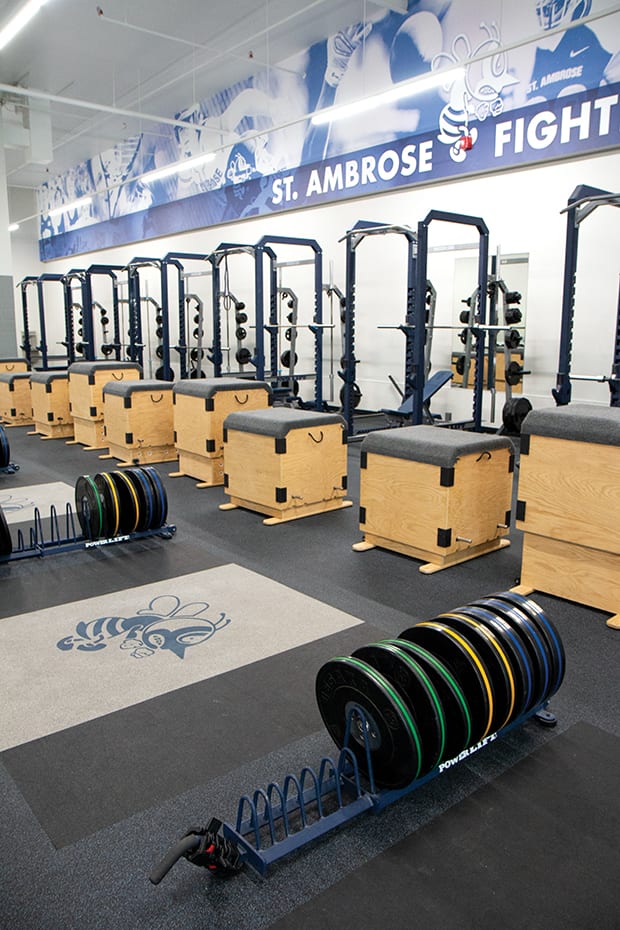
Panich echoed the sentiment of wanting the students to grasp life skills. She explained while Milton expects certain things from the student coordinators and supervisors, he’s also willing to listen to their opinions as it’s ultimately about collaboration.
In fact, Rasheed Deboard, a student facility supervisor, said both Milton and Fietterer relate to him and the rest of the students well. It’s a relaxed and fun environment while still eliciting professionalism from the students. “They’re both very good leaders in the fact they don’t yell at us if we do something wrong; they ask us what went wrong and then take us through it,” he said. “They’re very helpful and that’s what helps the most about being facility supervisor – if I have a question and I don’t really know what to do, they are very easy to talk to.”
Milton likes to ask what students are learning and how those lessons can be transferred to jobs. Attaching learning outcomes to job descriptions also gives students a heads-up on what they should be taking away from their time while working for wellness and recreation.
Ultimately, it comes down to the student’s best interest. Just like building the facility and making decisions that would benefit the student population as a whole, Milton and his team work to do the same on a daily basis. Fietterer even shared they’ve developed an Adulting 101 program for those in their department, using it to educate students on topics like negotiating salaries and providing workshops for items like resumes.
Since starting at St. Ambrose, Milton has picked up several lessons along the way. “I’ve learned a lot more patience, I’ve learned a lot more flexibility in schedules, and I’ve learned about communication skills,” he shared. “You have to be nimble and ready to ‘jam’ as I call it when you thought you were going to work on these things, but other things came up you now must tend to.”
Many of those lessons were through the years of watching the new facility come to life. Overcoming challenges, St. Ambrose’s team is stronger for it, as is the impact campus recreation will have on campus. So while the view from the group fitness room might be remarkable, the WRC itself is something to behold. “Sheer size, scope and placement on our campus [makes the Wellness and Recreation Center stand out],” said Milton. “It is poised to be a calling card for our campus for years to come.”


